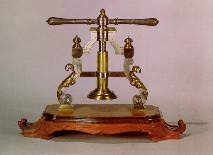
36 x 47,5 x 20
Iron, brass and carved wood
INDEX 1788: A.II.13
Praelum partim ex ferro, partim
ex orichalco, ad comprimendas pilas aqua fere impletas.
A press part in iron, part in brass, to compress balls almost full of water.
The spheres were placed on a metal support under the piston of the press. When the crank of the press was turned around its vertical axis, the piston descended, compressing the lead sphere which became slightly deformed. By increasing the pressure of the piston against the sphere, little droplets of water began to appear on the outside, without a pronounced deformation of the sphere. This result illustrated that water is not very compressible, and at the same time showed the porosity of lead.
These type of experiments were frequently performed in the 18th century to demonstrate the impenetrability of matter. The atribution of this property to fluids was particularly controversial. Nevertheless, for the modern physicists of this century, all matter was composed of very small solid particles, and that solidity would justify the impenetrability of both solids and fluids. In the case of the experiment described above, if the water passed through to the exterior of the sphere, it would mean that it was possible for the small solid particles of the water to run through the porous in the lead.
Dalla Bella used lead spheres in his experiments, while Musschenbroek indicated the use of silver spheres for similar experiments. Nollet, in his Leçons de Physique Expérimentale, refers to the generic use of metal spheres, citing the experiments of Boyle and the Baron of Zeruliano.
From Colégio dos Nobres, catalogue n.º 13.
Nollet, Jean-Antoine, Leçons de Physique Expérimentale, Paris, 1764, Vol. I, Pl. 2, p. 95, Fig. 5.